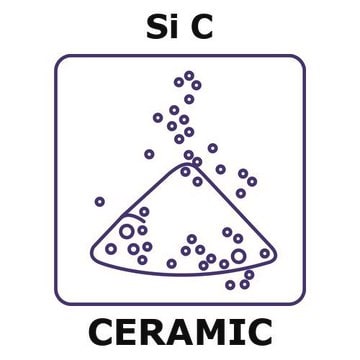Sigma-Aldrich offers a variety of nanoparticles (both as powders and as dispersions), organized in the Online Product Catalog by element.
594911
Silicon carbide
nanopowder, <100 nm particle size
Synonym(s):
Carbon silicide, Carborundum, Methanidylidynesilanylium, Silicon monocarbide
Select a Size
About This Item
Recommended Products
form
nanopowder
Quality Level
surface area
70-90 m2/g
particle size
<100 nm
mp
2700 °C (lit.)
density
3.22 g/mL at 25 °C (lit.)
bulk density
0.069 g/cm3
SMILES string
[C-]#[Si+]
InChI
1S/CSi/c1-2
InChI key
HBMJWWWQQXIZIP-UHFFFAOYSA-N
Looking for similar products? Visit Product Comparison Guide
Related Categories
General description
Application
- Overview of silicon carbide power devices: This document provides a comprehensive review of the characteristics and applications of silicon carbide (SiC) in power devices, discussing its advantages over traditional silicon devices in handling high voltages and efficiencies (Choi, 2016).
Physical form
Storage Class Code
11 - Combustible Solids
WGK
nwg
Flash Point(F)
Not applicable
Flash Point(C)
Not applicable
Personal Protective Equipment
Choose from one of the most recent versions:
Already Own This Product?
Find documentation for the products that you have recently purchased in the Document Library.
Customers Also Viewed
Articles
Composite materials with micron scale reinforcements offer tailored properties for various applications.
Silica's versatility spans various industries, including biomedical applications.
Three approaches generate white light, including LED-based down-conversion for broader applications.
-
I am interested in other types of nanoparticles. What does Sigma-Aldrich offer for my application?
1 answer-
Helpful?
-
-
How is Silicon carbide, Product 594911, synthesized?
1 answer-
Conventionally, silicon carbide is prepared using the Acheson process. Specifically, the supplier of these silicon carbide nanoparticles considers the method of manufacturing proprietary.
Helpful?
-
-
How does the storage temperature relate to shipping conditions?
1 answer-
The storage conditions that a Sigma-Aldrich catalog and label recommend for products are deliberately conservative. For many products, long-term storage at low temperatures will increase the time during which they are expected to remain in specification and therefore are labeled accordingly. Where short-term storage, shipping time frame, or exposure to conditions other than those recommended for long-term storage will not affect product quality, Sigma-Aldrich will ship at ambient temperature. The products sensitive to short-term exposure to conditions other than their recommended long-term storage are shipped on wet or dry ice. Ambient temperature shipping helps to control shipping costs for our customers. At any time, our customers can request wet- or dry-ice shipment, but the special handling is at customer expense if our product history indicates that the product is stable for regular shipment.
Helpful?
-
-
Does Silicon carbide, Product 594911, have any surface modification?
1 answer-
According to the supplier, the surface of these silicon carbide nanoparticles are not modified in any way. The material consists solely of silicon and carbon.
Helpful?
-
-
What is the Department of Transportation shipping information for this product?
1 answer-
Transportation information can be found in Section 14 of the product's (M)SDS.To access the shipping information for this material, use the link on the product detail page for the product.
Helpful?
-
Active Filters
Our team of scientists has experience in all areas of research including Life Science, Material Science, Chemical Synthesis, Chromatography, Analytical and many others.
Contact Technical Service



